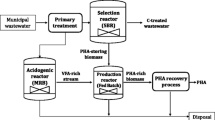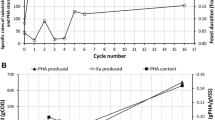Abstract
Polyhydroxyalkanoates (PHA) are good candidates to plastics because of their material properties similar to conventional plastics and complete biodegradability. The use of activated sludge can be a cheaper alternative to pure cultures for PHA production. In this study, effect of nitrogen limitation during acclimatization period of biomass on production of polyhydroxyalkanoate was investigated. Activated sludge was selected in two sequencing batch reactors operated with and without nitrogen limitation. Batch tests were performed to examine polymer productions of activated sludges acclimatized to different nitrogen regimes. Responses of biomass to different organic loading rates, organic acids, and carbon to nitrogen (C/N) ratios were studied by determining specific polymer storage rate, polymer storage yield, and sludge polymer content of biomasses. Results obtained from batch experiments showed that concentrations of polymer accumulated by two different sludges increased directly with initial substrate concentration. Observed highest polymer yields for the biomasses enriched with and without nitrogen deficiency were 0.69 g COD PHA g−1 COD S and 0.51 g COD PHA g−1 COD S, and corresponding polymer contents of biomasses were 43.3% (g COD PHA g−1 COD X) and 38.3% (g COD PHA g−1 COD X), respectively. Polymer yields for both biomasses decreased with substrate shift however, biomass enriched with nitrogen deficiency adapted well to acetate–propionate mixture. The results presented in this study showed that polymer storage ability of biomass was improved more under dynamic conditions with nitrogen deficiency when compared to that without nitrogen deficiency. Limiting ammonia availability during batch experiments also caused higher polymer production by suppressing growth, as well as during enrichment of biomass.




Similar content being viewed by others
References
Satoh H, Iwamoto Y, Mino T, Matsuo T (1998) Activated sludge as a possible source of biodegradable plastic. Water Sci Technol 38(2):103–109
Chua ASM, Takabatake H, Satoh H, Mino T (2003) Production of polyhydroxyalkanoates (PHA) by activated sludge treating municipal wastewater: effect of pH, sludge retention time (SRT), and acetate concentration in influent. Water Res 37:3602–3611
Dionisi D, Majone M, Papa V, Beccari M (2004) Biodegradable polymers from organic acids by using activated sludge enriched by aerobic dynamic feeding. Biotechnol Bioeng 85(6):569–579
Lemos PC, Serafim LS, Reis MAM (2006) Synthesis of polyhydroxyalkanoates from different short-chain fatty acids by mixed cultures submitted to aerobic dynamic feeding. J Biotechnol 122:226–238
Serafim LS, Lemos PC, Albuquerque MGE, Reis MAM (2008) Strategies for PHA production by mixed cultures and renewable waste materials. Appl Microbiol Biotechnol 81:615–628
Majone M, Beccari M, Di Gregorio S, Dionisi D, Vallini G (2006) Enrichment of activated sludge in sequencing batch reactor for polyhydroxyalkanoate production. Water Sci Technol 54(1):119–128
Albuquerque MGE, Eiroa M, Torres C, Nunes BR, Reis MAM (2007) Strategies for the development of a side stream process for polyhydroxyalkanoate production from sugar cane molasses. J Biotechnol 130:411–421
Serafim LS, Lemos PC, Oliveira R, Reis MAM (2004) Optimization of polyhydroxybutyrate production by mixed cultures submitted to aerobic dynamic feeding conditions. Biotechnol Bioeng 87(2):145–160
Bengtsson S, Werker A, Chrisstensson M, Welander T (2008) Production of polyhydroxyalkanoates by activated sludge treating a paper mill wastewater. Bioresource Technol 99:509–516
Dionisi D, Majone M, Tandoi V, Beccari M (2001) Sequencing batch reactor: influence of periodic operation on physiological state, microbial composition and performance of activated sludge in biological wastewater treatment. Ind Eng Chem Res 40:5110–5119
Dionisi D, Beccari M, Di Gregorio S, Majone M, Papini MP, Vallini G (2005) Storage of biodegradable polymers by an enriched microbial community in a sequencing batch reactor operated at high organic rate. J Chem Technol Biotechnol 80:1306–1308
Dias JML, Lemos PC, Serafim LS, Oliveira C, Eiroa M, Albuquerque MGE, Ramos AM, Oliveira R, Reis MAM (2006) Recent advances in polyhydroxyalkanoate production by mixed aerobic cultures: from the substrate to the final product. Macromol Biosci 6:885–906
Johnson K, Jiang Y, Kleerebezem R, Muyzer G, van Loosdrecht MCM (2009) Enrichment of a mixed bacterial culture with a high polyhydroxyalkanoate storage capacity. Biomacromolecules 10:670–676
Johnson K, Kleerebezem R, Muyzer G, van Loosdrecht MCM (2010) Influence of ammonium on the accumulation of polyhydroxybutyrate (PHB) in aerobic open mixed cultures. J Biotechnol 147:73–79
Johnson K, Kleerebezem R, Muyzer G, van Loosdrecht MCM (2010) Influence of the C/N ratio on the performance of polyhydroxybutyrate (PHB) producing sequencing batch reactors at short SRTs. Water Res 44:2141–2152
Beun JJ, Paletta F, van Loosdrecht MCM, Heijnen JJ (2000) Stoichiometry and kinetics of poly-β-hydroxybutyrate metabolism in aerobic, slow growing, activated sludge cultures. Biotechnol Bioeng 67(4):379–389
APHA, AWWA, WPCF (2005) Standard methods for the examination of water and wastewater, 21st edn. American Public Health Association, Washington, DC
Greenberg AE, Clesceri LS, Eaton AD (1992) Standard methods for the examination of water and wastewater. American Public Health Association, Washington, DC
Acknowledgments
This work was supported by the Scientific Research Projects of Istanbul Technical University (project no. 32571). We wish thank to Halkalı Kağıt for kindly providing the sludge used as inoculum.
Author information
Authors and Affiliations
Corresponding author
Rights and permissions
About this article
Cite this article
Basak, B., Ince, O., Artan, N. et al. Effect of nitrogen limitation on enrichment of activated sludge for PHA production. Bioprocess Biosyst Eng 34, 1007–1016 (2011). https://doi.org/10.1007/s00449-011-0551-x
Received:
Accepted:
Published:
Issue Date:
DOI: https://doi.org/10.1007/s00449-011-0551-x




